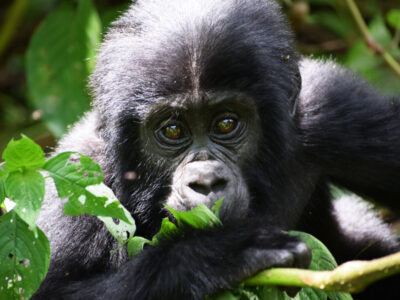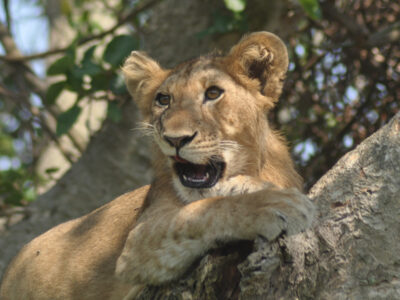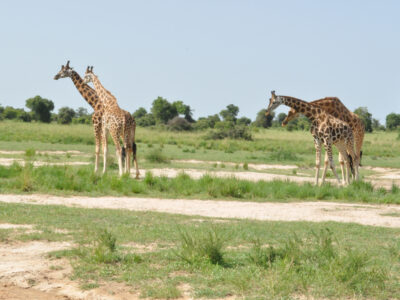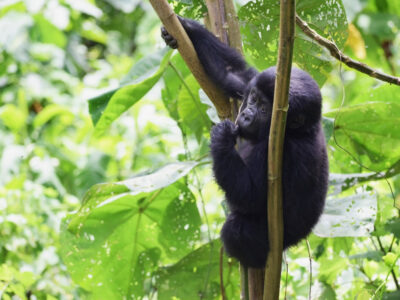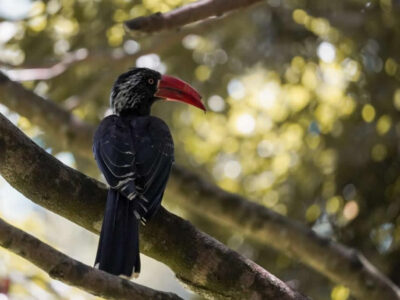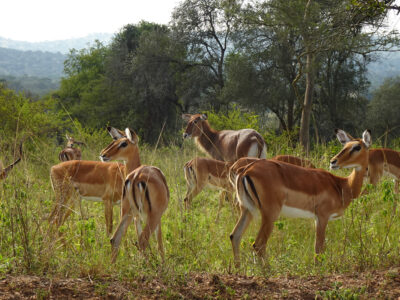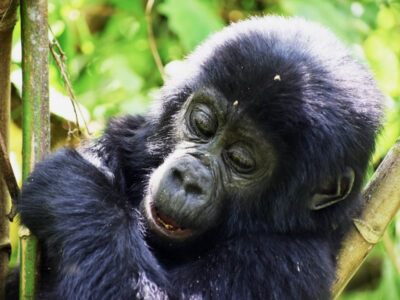Most people choose to go on safari in Uganda since it is one of the most stunning countries in all of Africa. Uganda, the unspoiled Pearl of Africa, has some of the most beautiful landscapes on Earth and one of the most spectacular views in all of Africa. Unparalleled Uganda safari experiences can always be expected by visitors. It features amazing scenery, abundant animals, and special tour opportunities. Since each national park in Uganda has a distinct flavor that sets it apart from the others, visiting all 10 won’t give you the same experience.
While seeing lions, giraffes, gorgeous elephants, chatty chimpanzees, chattering birds, and gentle mountain gorillas in the dark jungles of south-western Uganda. The thrilling National Parks in Uganda provide a variety of tour activities for safaris, including unrivaled gorilla encounters, incomparable wildlife viewing, boundless nature trails, chimpanzee trekking tours, mountaineering, and amazing bird-watching experiences. Even with only 10 National Parks, choosing which ones to visit is quite difficult because every single one of them has something special and intriguing to offer.
MURCHISON FALLS NATIONAL PARK
Starting with the spectacular Murchison Falls National Park, which is the country’s tourism crown gem and the oldest and largest protected area in Uganda, The majority of Africa’s renowned game species may be found in this protected area, which was established in 1952. These include Rothschild giraffes, Defassa waterbucks, Hartebeests, Topis, Uganda Kobs, Oribis, lions, African bush elephants, Cape buffaloes, and leopards, to name a few.
The massive 3893 square kilometer Murchison Falls National Park is located in the districts of Masindi, Kiryandongo, Bulisa, and Nwoya in northwestern Uganda. This beautiful park has been existing for more than 80 years and often attracts travelers seeking adventure tours from all around the world. This breathtaking National Park is home to over 451 bird species, 80 mammal species, and breathtaking scenery like the Victoria Nile and the powerful Murchison Falls.
The main attractions of the park
This park supports a lot of flora and fauna to delight the visitors from savannah and tall grass to thick bush and woodlands hence its diversity never ceases to amaze the visitors. Fishermen can test their skills above and below the falls by eagerly waiting for the big Nile perch, electric catfish, barbell, and tiger fish. A lot of animal species can be seen on a game drive like Cape buffalo, giraffes Uganda kobs and you may spot some oribi, bushbuck, reedbuck, the shy sitatungas, and warthogs
Since the spectacular falls can be seen from the top, where the Nile River narrows from 50 meters to crash through the canyon at a height of roughly 7 meters before flowing to the river, visiting Murchison Falls without seeing them is unavoidable and would be incomplete. Another amazing experience is the cruise to the falls’ base. While on board, guests can take in the splendor of the Nile and observe the diverse wildlife that abounds along the river’s banks. The more you hike the trails around the falls, the more you’ll want to look out for some of the 451 bird species that have been identified in the park.
Major tour activities at the park
Being the largest park, Murchison Falls National Park offers a wide range of activities, including the recently introduced hot air ballooning that is only done there. The game drives, boat cruises at the base of the majestic falls, nature walks through park woods and reserve centers, birding, and cultural encounters with the local tribes are some other activities. The ideal safari experience to have on Uganda tour is to visit Murchison Falls National Park.
MOUNT ELGON NATIONAL PARK
The 1,279 sq. km. Mount Elgon National Park, which is shared by Uganda and Kenya, is divided into two portions by the borders of those two countries. Although they were gazetted in Kenya in 1968 and Uganda in 1992, respectively, the Kenyan portion is 169 sq km larger than the Ugandan portion, which is 1110 sq km.
In the eastern section of Uganda, Mount Elgon, the world’s largest caldera mountain, has the greatest volcano base. It was originally the tallest mountain in the world, standing at 5,895 meters, but due to heavy erosion, its height has since been lowered to 4,321 meters.
Mount Elgon has five main peaks: Sudek, Koitobos, Mubiyi, Wagagai, and Masaba. It is home to Mount Elgon, a national park, and as you ascend it, you pass through moorlands that display a wonderful natural setting. Everyone aspires to walk and reach Wagagai, the mountain’s 4,321-meter highest peak. It is the oldest volcano in East Africa, and the woods on either side of it are a haven for both mammals and birds.
Attractions at Mt Elgon national park
It offers lovely wildlife, including caves and waterfalls like Sipi Falls, which let you take pleasure in going up to the highest summit. In addition to the park’s main features, Mount Elgon and the Sipi Falls, a variety of species including elephants, squirrels, hyenas, buffalos, oribis duikers, and certain primates like the blue monkey and white colobus monkeys may also be found there.
The Sipi Falls, which is a spot to experience mountain challenges as well as to repose in a serene, calm environment, is the park’s most alluring feature. Along with a range of other activities, Sipi Falls provides access to Mount Elgon adventures, trekking, climbing, riding, and Lake Kyoga fishing.
It includes three sizable waterfalls that are situated in east Uganda’s Mount Elgon hills, the world’s largest volcanic base and the home of amazing bird species. The three waterfalls are 75 meters, 85 meters, and 100 meters in height, respectively, so the climb becomes challenging as you get access to better mountain views. You can also enjoy the cold wind of the appealing moments as you observe the sunsets in the evening.
Major activities at the park
The park has a lot of activities that do happen like; bird watching about 300bird species, spot fishing at the falls, nature walk, mount climbing, biking, and more, this is where the Bagisu culture believes in male circumcision is found. The Bagisu tribe is known for performing the rituals of circumcision dancing from one place to another in the villages for a specific period of time on the day of circumcising, from there you were considered a man and free to marry a woman.
Mount Elgon national park also supports various activities and attractions besides the above including the Arabic coffee plantation that covers a wide area, cave paintings near the trails of Budadiri, and a hot spring in the volcanos.
Mount Elgon National Park can be visited at any time of the year for different activities, however, the best period to visit is during the dry seasons which occur in January, February, June, and October although the wet season is there, it cannot hinder you to enjoy hiking the trails of the mountain although it keeps on changing,
The park has numerous accommodations within and around the park stretching from budget to luxury facilities and these include, Mbale Resort Hotel, Mount Elgon Hotel, Lacam Lodge, Kapkwai Forest Cottages, Noah’s Ark Resort, Kapwata Guest House, Roses Last Chance, Sasa River Camp, and others all deliver best and comfortable sleeping and leisure Services to visitors.
SEMULIKI NATIONAL PARK
This is the best park ever known suitable for bird watching, if you are a bird watcher and looking where to experience most of the birds in Uganda and some parts of the world just look nowhere because this is the best destination for birders that’s why it’s called “The True Birders Haven.
It is located in the western part of Uganda, in Bundibugyo district close to Fort-portal city. It was designed as a forest reserve in 1932 and later after turned into a national park in 1993 covering 220 sq. km and most of the area is covered with tropical rainforests. It is shared between two countries that are Uganda and DR Congo lying on the floor of Semuliki valleys.
Semuliki national park lies on a gentle landscape extending from 670-760 m above sea level within Albertine rift valley and Lake Albert in the north under a protected area network including Kibale national park, and mountain Rwenzori Park.
The park occupies over 435 bird species and a birder is guaranteed to view almost every bird species including the rift valley birds and Congo species, some of them include; the black dwarf hornbill, dwarf honey guide, purple-breasted sunbirds, Congo serpent eagle, Gabon woodpecker, capuchin babbler, orange weaver, white-tailed hornbill, and others.
The other attraction of the park the hot springs that bubble up from depth to show the powerful forces that have been forming the rift valley for many years, they are divided into a pair (a male hot spring called Bintente and a female one called Nyansimbi spring), people can cook their plantains on the pools that surround the spout.
Sempaya trail that allows access to Sempaya hot springs and through the forest were likely to meet with black and white colobus monkeys, and grey-cheeked mangabeys. Secondly, the red monkey trail that leads you to Semuliki River through park ridges and here there is a chance of crossing with rare debrazza monkeys and lastly, the kirumia trail which is about 13 km is suitable for bird-watchers, it crosses the forest and ends in the river.
Activities to do at Semuliki national park
The park allows different activities that can take place deep in the forest with a guided ranger through different trails that allow access to the park such as;
During your game drive on the park, you will encounter various wildlife almost 60 species of animals like the Uganda kobs, waterbucks, elephants, buffalos, and crocodiles inhabited, 8 primate species, and over 460 species of butterflies. In addition to those animals, you may spot lions, leopards, and bush babies as they also exist in this park though they are very scarce and tend to hide in the forests
Community and cultural experiences are carried out in this park, there is the Batwa tribe who lives within the park boundaries but tend to visit the forest often for food and medicine, they have a serenity performance in music, and their way of living is amazing, and their beautiful handmade crafts.
Visiting the Sempaya hot springs during the nature walks in the park. These are the famous attractions in the park that captivate visitors, during a nature walk to these hot springs, visitors encounter several species of birds including small primates in the trees. There is a tower and boardwalk constructed for visitors to observe the hot springs at a safe distance.
There is chimpanzee trekking in Semuliki national park that visitors engage in during a safari to Uganda although the activity is not common as that of Kibale national park. Chimpanzees in Semuliki Park tend to move quickly in tree branches and spotting them can be difficult and it is mostly done together with the researchers using their trails.
Semuliki National Park contains beautiful lodges and hotels suitable for accommodation for visitors that you never worry about where to spend the night, these include; Kyaninga Lodge, Rwenzori View Guesthouse, and Mountains of the moon Hotel. Accessing Semuliki national park from Kampala drive via Fort portal takes 4 hours with a stopover.
KIDEPO NATIONAL PARK
The park is located in the northern part of Uganda and is the furthest protected park, tagged “the true African wilderness” due to its lonely and far from cities and urban life, still enjoys the beauty of what a true wilderness in Uganda is.
The park originated from a far distance place than the rest of the national parks for someone traveling by road spend almost the entire day on the road trip since their routes are far about 795 km, and they cover almost 10-12 hours’ drive distance.
Kidepo national park is a semi-arid region with average temperature and goes extreme during day time, this follows only one rainy season received in a year although this season may seem to be long but is inconsistent. The soil in this region is sandy that cannot hold water for so long in the ground resulting in grasslands and shrubs being vibrant during the rainy season and withering immediately in the dry season.
Following its wilderness, the park has quite a big number of wildlife including buffalos, leopards, antelopes, elephants, and some unique ones like the cheetah which can be spotted only in this park in the whole of Uganda.
The attractions of Kidepo National park
Kidepo National Park has quite a number of attractions such as the Kanangorok hot spring where you can see various animal species like the ostrich, buffalos, Jackson’s hartebeest, klipspringer, and other animals its panorama landscape gives a clear view of the park’s wilderness. The Narus valley offers a wonderful nature walk, and cultural encounters with the Karamojong and the IK people are one of the best cultural encounters to experience
While in this park you will be able to view almost every wildlife species like over 77animal species including approximately 20 predators like leopards, spotted hyenas, lions, wild dogs, and other animals such as the buffalos, African elephants, giraffes, zebras, and Oribis, elands, Topis, gazelles, and other animals.
Kidepo National Park has more than 400 bird species and 50 birds of prey including the rare Ostrich bird found only in this park, Kori bustard, Little bee-eater, Red-and-yellow barbet, Dark chanting goshawk next to Queen Elizabeth national park, this makes the park to be the second place to hold the largest number of bird species. It has a number of game rangers that are professional in guiding through identifying different species of birds in their nests and identifying various characteristics of different animal species to visitors.
Activities carried out at the park
There are activities spotted that give you an amazing natural experience, the beautiful view of the sloping savannah grasslands, and a cultural walk to Karamojong homes commonly known as the “Manyattas”. The Karamojong live a nomadic pastoralist life moving from one place to another with no permanent settlements perhaps they are famous as cattle keepers who love their cattle and culture.
Cultural encounters with the nearby communities the Karamojong, nature walks through different park trails studying the environment, birding for those who enjoy watching birds, and game drives in the park’s wilderness.
BWINDI IMPENETRABLE NATIONAL PARK
There is no doubt that Bwindi Impenetrable National Park in the southwestern corner of the country is one of the must-visit National Parks on Uganda safaris. This beautiful UNESCO World Heritage Site is home to the world-famous endangered mountain gorillas. These primates are endangered and found in only three countries, and Bwindi is one of the National parks sheltering them surprisingly has the highest population of mountain gorillas in the world.
The is also part of the Bwindi impenetrable forest that borders along D.R of Congo next to Virunga national park it’s the home to more than half of the mount gorilla population in Africa. The landscape here is rugged with deep valleys running between steep sides and ridges barely almost a square mile of this park is flat. There is a blend of both lowland and rainforest with a dense growth of a variety of tree species (hence adopt the name impenetrable)
This 331-square-kilometer National Park was established in 1991 in order to protect the endangered mountain gorillas from poachers. Queen Elizabeth national park has about 120 mammals, 350 birds that include the Albertine Rift endemics, over 200 butterfly species and so much more. During your visit to this Park, you can get the chance to track the mountain gorilla, undertake mountain biking, cultural tour of the Batwa pygmies, and many other adventures.
The park consists of 18 habituated families and these are being trekked by four (4) sectors of the park that Is Buhoma, Rushaga, Nkuringo and Ruhija sectors and these families are; Rusheguna, Habinyanja, Busingye, Bushaho, Oruzogo, Bweza, Shongi, Mishaya, Mucunguzi, Kahungye, Mabare and many others thus making trekkers enjoy a wonderful and memorable holiday tour on the park.
Bwindi Impenetrable National Park is a home of more than half of the mountain gorilla population in Africa over 450individuals and this is the only park where mountain gorillas and chimpanzees co-exist together, however, there are other attractions including animals about 120 species (more than any park in Uganda except Queen Elizabeth), birds (estimated about 360 species), about 300 species of butterflies( including 2 endangered species of swallowtails), trees about 200 species, plants and many species of reptiles and amphibians including frogs.
The park area is regarded as the most biologically diverse forest in Africa with the richest fauna community in east Africa. The flawless rainforests of the park known as the largest natural forest in east Africa, act as a home to butterflies, reptiles, and mammals. The rugged terrain of this park is stiff which makes gorilla tracking in this place strenuous work and visitors should be prepared for long hours therefore good physical condition is required.
MGAHINGA NATIONAL PARK
The three northern slopes of the Virunga volcanoes—Mount Muhavura (4127m), Mount Mgahinga (3474m), and Mount Sabinyo—are covered by the Mgahinga national park, which is situated in the southwest of Uganda (3645m). According to story, it is the tiniest and wealthiest national park in Uganda, located in the Kisoro district approximately 10 kilometers south of the volcanoes national park of Rwanda and west of the Democratic Republic of Congo. Mgahinga National Park is the smallest national park in Uganda, with a total area of 33.7 sq. km. It was first designated as a game reserve in the 1950s and then as a national park in 1991. Its elevation ranges from 2,227m to 4,127m above sea level.
A sizable population of golden monkeys, which are unique to this region of Uganda, is supported by the montane-woodland, montane-forest, and sizable area of bamboo forests. The only habituated mountain gorilla family the Nyakagazi family is habituated within mgahinga national park . This provides tourists who appreciate the stunning vista of the park with a tremendous natural beauty.
Mgahinga is a fantastic general trekking location in addition to gorilla treks and golden monkey excursions, both for standard tours and the extended habituation adventure tours. All three of the virunga mountains are reachable from Uganda: Mount Gahinga, Mount Sabyinyo, and Mount Muhabura, provide strenuous guided treks to their peaks.
Main activities to do at the park
Gorilla trekking: The gorilla trekking process in Mgahinga is similar to that in Bwindi. Around nine in the morning, treks start. The distance you must travel to reach the gorilla family will determine how long the expedition will take. There is only one family that has been accustomed to making contact in Mgahinga, despite the fact that gorilla families frequently cross the border from Uganda to Rwanda, the Nyakagezi family is now settled and habituated in uganda.
Golden monkey trekking: Large, curious, and cheeky blue monkeys family known as “golden monkeys” can be seen in the bamboo zone of the Virunga Volcanoes. Their black limbs, crown, and tail-end contrast sharply with their bright orange-gold body, cheeks, and tail. They don’t stop their foraging or fun behaviors because they are accustomed to human visitors. The hike, which is strenuous but typically not as difficult as tracking gorillas, is found above 2,500 meters. There are two options: the regular walk, which includes an hour of contact, and the habituation trek, which involves spending significantly more time on the mountain with the study team.
Guided hikes: There are excellent guided walking trails that take you quite far up the mountains that are accessible for people staying in Mgahinga for longer than a few nights. Every day at around 7:30, the treks start, and depending on the participants’ fitness and interest, they can last anywhere from 7 to 9 hours. After ascending 1,793m from the trailhead, hikers should watch out for signs of high altitude sickness. While there are no rock cliffs to negotiate, the trip across the Afro-montane moorland does need grit and perseverance. The Muhabura Peak’s 4,127m peak is the highest climb.
MT RWENZORI NATIONAL PARK
Mt Rwenzori national park is the fabled “mountains of the moon” that lay in western Uganda along the Congolese border. The snow-capped equatorial summits rise around 5,109m, while the lower slopes are covered with montane forest. The majority of the park is only accessible by hikers, yet the spectacular scenery and Albertine rift valley would be enough reward for birders. As a result, the park is a world-class destination for mountaineering and hiking.
Mount Rwenzori is Africa’s third tallest mountain range, behind Mount Kilimanjaro and Mount Kenya. It also has six main peaks separated by many deep canyons, including the highest Mount Stanley, Mount Speke, Mount Baker, and others.
Mount Rwenzori National Park is made mainly of metamorphic rocks and gorges pushed upwards by tectonic plate movements. The park is a magical place for hikers and bird watchers that should be explored. The park contains several indigenous species in the Albertine lowlands, as well as several scary species that follow a diverse range of tree types.
It is estimated to have 89 different bird species, 15 different butterfly species, and four different primate species, including the forest elephant, chimpanzee, hyrax, black-and-white colobus, Lhotse monkeys, and Ruwenzori duiker.
Mount Rwenzori favors the trekkers as soon as they enter the bamboo-mimulopsis zone which is a steep climb with many high steep slopes, in the wet season the bamboo area is rather muddy and slippery making the trekking slow, however, the atmosphere is beautiful as you climb 551 meters altitude and a distance of 1.8km to kalalama camp which is in Rapannea zone where you can take a rest and catch a cup of tea before you resume to the next hike
The trail meanders over small humps along the ridge top then drops down on the side of the valley before climbing again crossing several streams and passing close to the waterfalls
Mount Rwenzori national park has a variety of tree species the more you climb up the more plants and flowers, the valley is unique with a mixture of enormous trees and plant species creating a beautiful atmosphere wrapped within trees like lobelia, bamboo, groundsels, and others.
A number of activities can be carried out within the park including hiking the Rwenzori Mountain which most visitors are attracted to, conducting tours around the park communities, bird watching due to different species of birds found in the park, nature walks within the mountain trails while observing wild animals and beautiful vegetation.
Rwenzori mountain offers a wide range of accommodations according to your wallet capacity, they vary from the budget, mid-range standard, and luxury service facilities providing the best services to visitors, these include, Ruboni community camp providing beautiful wooden cottages that support climate weather around the snow-capped mountain, Rwenzori international hotel, Rwenzori trekkers hotel, creature comfort lodge, Geology equator snow-lodge, Margherita hotel for luxury comfort stay, and many others.
QUEEN ELIZABETH NATIONAL PARK
With its numerous ecosystems/landscapes that include forests, marshes, lakes (freshwater and crater), the Kazinga Channel, huge savannah grasslands, and woodlands, Queen Elizabeth national park in western Uganda is one of the must-visit national Parks on Uganda safaris. The fact that this park is home to the tree-climbing lions found in its southern Ishasha region stands out among its numerous undeniable reputations.
Queen Elizabeth National Park is one of Uganda’s outstanding resources; it was recently named a biosphere reserve for humanity. It is Uganda’s most popular and conveniently accessible game reserve. The park covers 1978 square kilometers and contains a diverse range of ecosystems, including semi-deciduous tropical forests, green meadows, savannah, and swamps.
Queen Elizabeth park attractions
The Uganda kobs, a famed tree-climbing lion, as well as elephants, hippos, buffaloes, baboons, and chimpanzees are said to reside here, along with roughly 95 other species of mammals, the biggest number of any national park in Uganda. In the relatively small reserve of Queen Elizabeth National Park, approximately 600 confirmed species of birds as well as 15 unconfirmed species have been identified. These species include the shoebill stock, black bee-eater, kingfishers, and a number of predators, including several falcons and eagles. Amazing flamingo flocks congregate in the crater lakes, giving the impression of a moving pink carpet.
In the eastern part of the park is Kyambura gorge where visitors can climb through a tropical forest in hopes of catching a glimpse of a variety of primates including the chimpanzees. And in the more isolated Ishasha sector of the park, visitors can move through the woodlands in search of tree-climbing lions perched on the boughs of ancient fig trees. To the southwest, visitors can explore newly opened trails in the Maramagambo forest.
Activities to do at Queen Elizabeth national park
Queen Elizabeth national park is one of the most visited national parks in Uganda with a number of tourists exploring the best of the park. The park has a number of tour activities tourists can involve in during their adventure tour such as the famous game drives, boat cruises on the Kazinga channel, chimpanzee trekking in Kyambura gorge, nature walks, and involve in thrilling Obadia home stay activities.
KIBALE NATIONAL PARK
Kibale national park is located in the western part of Uganda about 348km from Kampala, it’s also closely located in Rwenzori mountains, Semuliki national park, and a half-day drive to Queen Elizabeth national park in the southern part of the park. It was established in 1993 to protect the moist evergreen rainforest and some endangered primates. It is occupied an area of about 766 sq. km in size and ranges between 1,100 meters and 1,600 meters in elevation.
The park is covered with moist green rainforest and is well known for protecting chimpanzees which occupy the highest number in this park and the nature walks in this park offer an opportunity to track chimpanzees in their homes.
Kibale national park attractions
The main attraction to Kibale National Park is the high density of primates that inhabits the rainforest and the wet tropical forest is said to support the highest number of primate species in Uganda, following the high community of chimpanzee about 12 species which include; the red-tailed monkey, black and white colobus monkey and many more.
The bird life is hilarious with over 380 species recorded for the area highlights include the crested quince fowl, Grey Blue Turaco, Grey Parrots Green-Breasted African Pittas, The African Crowned Eagles and Black Bee Eaters are found in this park.
Kibale national park is home to numerous wildlife attractions not only the primates that live in the thick dense forest but also other animals that include leopards, buffalos, bush pigs, warthogs, bushbucks, forest hogs, sitatungas, golden cats, African palm civet, alexander duiker, mash mongoose otters and many more
Striking vegetation: Kibale national park has a thick forest covering spectacular vegetation that consists of about 250 tree species that include eucalyptus, pine trees, Lovoa swynnertonii, Cordia millenii, Entandrophragma, and many more others.
The Ndali Kasenda Crater Lake is situated near the park area and offers a breathtaking view of the other 60 or more seasonal crater lakes filled with fresh water. Region contains, to name a few, Lake Ntambi, Lake Mubiro, Lake Nyamasingiri, Lake Kifuruka, Lake Nyinambuga, Lake Nyabikere, and Lake Nkuruba. These lakes were made by Ndahura, the Chwezi dynasty’s monarch at the time after being ousted by his own son, according to a memorable and lovely account about them. They provide the stunning natural greenery that surrounds them and serve as homes for more than 250 different species of butterflies.
Major activities at Kibale national park
Kibale national park is well located with amazing wildlife that attracts a variety of activities that includes the wonderful nature walk in the Bigodi wetland for thrilling bird watching, and animal viewing, chimpanzee trekking and habituation activities in the tropical forest, visiting the Amabere ga Nyinamwiru in the nearby fort portal town.
LAKE MBURO NAIONAL PARK
Conveniently situated geographically close to the highway connecting Kampala to the parks in western Uganda. The smallest of Uganda’s savannah national parks is Lake Mburo. The Kiruhura neighborhood, which is close to Mbarara city, is home to Lake Mburo National Park. Because there are no elephants in the park to consume this type of vegetation, savannah, marshlands, and acacia forests make up the majority of the vegetation in Lake Mburo National Park.
Between 1200 and 1830 meters above sea level, Lake Mburo was declared a hunting area in 1933, a game reserve in 1963, and a national park in 1983 when Bahima Banyankole pastoralists were driven out of the parking area. Since then, it has attracted a number of tourists who want to see its stunning features and see the various animals that live there.
It occupies an area of about 260sq.km that is covered with wooded savanna vegetation, bush thickets, dry hills, swamps, and rocky outcrops. Lake Mburo national park receives between 500mm-800mm of rain since it lies within rain shadows between the Rwenzori Mountains and Lake Victoria
Lake Mburo national park is best known for vast vegetation and a variety of wildlife ranging from topi, Oribis, reedbuck, Rothschild giraffe, and Burchell’s zebra that are endangered in this park and kidepo valley national park, buffaloes, leopard duikers, zebras, and many others, apart from elephants and rhinos that are absent in the park and rare lions that tend to visit the park occasionally including impalas that are found only in lake Mburo and elands and warthogs and hippos that are commonly seen in the park.
Lake Mburo National Park’s attractions
Apart from elephants and rhinos, which are absent from the park, and rare lions that occasionally visit the park, including impalas, which are only found in Lake Mburo, as well as elands and warthogs, Lake Mburo National Park is best known for its extensive vegetation and a variety of wildlife, including topis, Oribis, reedbuck, Rothschild giraffes, Burchell’s zebras, and many others.
There are four large, scenic lakes in the Lake Mburo national park, including the main lake Mburo. The national park surrounding Lake Mburo is made up of numerous additional small lakes.
Things to do at Lake Mburo national park
Game Drives: Visitors can go on game drives in the Lake Mburo National Park to see a variety of species. In Savannah Game Parks, it is the most well-liked activity. They are always done in vehicles with park guards and guides to see the different creatures and birds that call the park home. Several elands, impala, zebra, waterbuck, topi, giraffes, buffalo, and other creatures can be seen during a game drive.
Boat Cruise: Taking to the water is typically a tranquil and relaxing aspect of the safari, so this is another great activity. This ensures that tourists will be able to see the incredible flora and fauna, including zebras, crocodiles, hippos, and antelopes, as well as bird species like pelicans, kingfishers, and herons.
Horse Riding: The only national park in Uganda that allows tourists to ride horses as part of a game activity is Lake Mburo. Although they remain a safe distance from them and appear amused, some animals, such as zebras, buffaloes, antelopes, and elands, allow tourists to get a close look at them because they recognize these horses.
Birding: Lake Mburo National Park is ideal for birding due to its wetlands, acacia trees, and savannah flora, and its swampy sections surrounding Miriti and Waruki offer the greatest views of bird species. In this park, you can see birds such the blue-billed barbet, brown parrots, Rufous-bellied heron, white-winged warbler, black-bellied bustard, southern red bishop, and red-faced barbet.
Spot Fishing: With its stunning five well-known lakes, including Lake Mburo, the largest lake, and other minor lakes totaling about 12, Lake Mburo National Park is a great place to go fishing. Nearly six different fish species can be caught in these lakes, with tilapia being the most popular catch.
Note: Even though Uganda’s 10 national parks are spread out across the nation, you can visit them any time of year. There are only two distinct seasons in Uganda, and each one is favorable to the exhilarating adventure tour to these national parks. However, for simple access and road navigation within the national parks, the dry season is the optimum period to visit.

